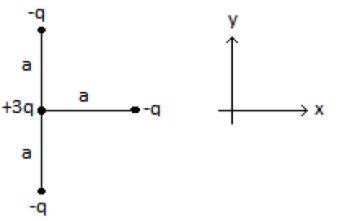
Dipole moment of the arrangement of the charges as shown in figure is


Answer
558.3k+ views
Hint: To solve the given question, we need to dive into the concept of dipole moment which is a quantity that describes two opposite charges separate by a small distance. The formula used to measure dipole moment is $\vec{p}=q.\vec{d}$ where $\vec{d}$ is the distance between the two charges directed from negative to positive charge and its SI unit is coulomb meter.
Complete answer:
Considering the direction in the $x-axis$ and $y-axis$ to be along positive $\hat{i}$ and $\hat{j}$
We may proceed to solve the dipole moment of each dipole to solve the question with respect to the $+3q$ charge,
Dipole moment of $-q$ along the direction of positive$y-axis$,\[{{\vec{p}}_{1}}=-q\times \vec{a}\left( {\hat{j}} \right)\]
Dipole moment of $-q$ along the direction of positive$x-axis$,\[{{\vec{p}}_{2}}=-q\times \vec{a}\left( {\hat{i}} \right)\]
Dipole moment of $-q$ along the direction of negative$y-axis$, \[{{\vec{p}}_{3}}=-q\times \vec{a}\left( -\hat{j} \right)\]
Equivalent or net dipole moment of the system,${{\vec{p}}_{net}}$ will be equal the vector sum of all the dipole moments with respect to $+3q$ charge, that is
${{\vec{p}}_{net}}={{\vec{p}}_{1}}+{{\vec{p}}_{2}}+{{\vec{p}}_{3}}$
Now, in the next step of the vector sum \[{{\vec{p}}_{1}}\] and \[{{\vec{p}}_{3}}\]would cancel each other as they have diametrically opposite directions.
$\therefore {{\vec{p}}_{net}}={{\vec{p}}_{2}}=-q\times \vec{a}\left( {\hat{i}} \right)$
Thus, the equivalent dipole moment of the system is \[-q\times \vec{a}\] along the direction of positive $x-axis$.
Note:
One is advised to always remember that dipole moments determine the direction of the charges, thus, can have both positive and negative values and if required can be resolved into its rectangular components .This again justifies that it’s a vector quantity.
Complete answer:
Considering the direction in the $x-axis$ and $y-axis$ to be along positive $\hat{i}$ and $\hat{j}$
We may proceed to solve the dipole moment of each dipole to solve the question with respect to the $+3q$ charge,
Dipole moment of $-q$ along the direction of positive$y-axis$,\[{{\vec{p}}_{1}}=-q\times \vec{a}\left( {\hat{j}} \right)\]
Dipole moment of $-q$ along the direction of positive$x-axis$,\[{{\vec{p}}_{2}}=-q\times \vec{a}\left( {\hat{i}} \right)\]
Dipole moment of $-q$ along the direction of negative$y-axis$, \[{{\vec{p}}_{3}}=-q\times \vec{a}\left( -\hat{j} \right)\]
Equivalent or net dipole moment of the system,${{\vec{p}}_{net}}$ will be equal the vector sum of all the dipole moments with respect to $+3q$ charge, that is
${{\vec{p}}_{net}}={{\vec{p}}_{1}}+{{\vec{p}}_{2}}+{{\vec{p}}_{3}}$
Now, in the next step of the vector sum \[{{\vec{p}}_{1}}\] and \[{{\vec{p}}_{3}}\]would cancel each other as they have diametrically opposite directions.
$\therefore {{\vec{p}}_{net}}={{\vec{p}}_{2}}=-q\times \vec{a}\left( {\hat{i}} \right)$
Thus, the equivalent dipole moment of the system is \[-q\times \vec{a}\] along the direction of positive $x-axis$.
Note:
One is advised to always remember that dipole moments determine the direction of the charges, thus, can have both positive and negative values and if required can be resolved into its rectangular components .This again justifies that it’s a vector quantity.
Recently Updated Pages
Master Class 12 Business Studies: Engaging Questions & Answers for Success

Master Class 12 Economics: Engaging Questions & Answers for Success

Master Class 12 English: Engaging Questions & Answers for Success

Master Class 12 Maths: Engaging Questions & Answers for Success

Master Class 12 Social Science: Engaging Questions & Answers for Success

Master Class 12 Chemistry: Engaging Questions & Answers for Success

Trending doubts
What are the major means of transport Explain each class 12 social science CBSE

Which are the Top 10 Largest Countries of the World?

Draw a labelled sketch of the human eye class 12 physics CBSE

Explain sex determination in humans with line diag class 12 biology CBSE

The pH of the pancreatic juice is A 64 B 86 C 120 D class 12 biology CBSE

Explain sex determination in humans with the help of class 12 biology CBSE




